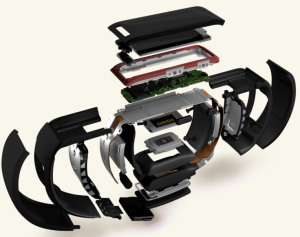 With Microsoft moving so aggressively toward cloud services and mobile technology, you could have seen this a mile away, even without the recent leak: the company has announced the Microsoft Band wearable and the Microsoft Health cloud service.
With Microsoft moving so aggressively toward cloud services and mobile technology, you could have seen this a mile away, even without the recent leak: the company has announced the Microsoft Band wearable and the Microsoft Health cloud service.
First, the band. It’s a full-featured device most closely resembling the Samsung Gear Fit. Black plastic, touch-sensitive color screen that’s 11 x 33 mm and a resolution of 320 x 106 pixels. It tethers to your phone — iOS, Android, or Windows Phone, and takes advantage of Cortanta voice recognition if you’re on a Windows Phone. Sensors include the usual accelerometer and gyro, but adds heart rate, galvanic skin sensor, body temperature, GPS, and a mic. Claimed battery life is 48 hours (less if you use GPS), and charging takes just 1.5 hours.
As is increasingly common, the Band also works as a notification device when tethered to your phone: texts, calls, calendars, emails, Facebook, Twitter, weather, stocks, can all be shown. Oh yes: the time, too — and a timer and stopwatch. It’ll even show your Starbucks card barcode. That’s a lot of technology for $199.
 The band syncs with RunKeeper, Golds Gym, and MyFitnessPal, which brings us to Microsoft Health cloud.
The band syncs with RunKeeper, Golds Gym, and MyFitnessPal, which brings us to Microsoft Health cloud.
The Health cloud connects with a Health app (iOS, Android, and Windows Phone), to collect and store your tracker data from Microsoft Band, Jawbone Up, MapMyFitness, and MyFitnessPal. The promise, Microsoft says, is to associate your fitness data with other Microsoft-held information about your life. If you use Outlook, for instance, Microsoft could tell you how business travel affects your training. Or if emails from your boss make you sweat and hyperventilate. Or if using a regression function in Excel makes you want to get up and walk around.
More realistically, perhaps, the Health cloud could use content from Gold’s Gym and Men’s Fitness to recommend an exercise routine to help you meet your goals, based on your existing movement patters.
Also, Microsoft promises that you’ll be able to share this information and insights with your doctor. It is, after all, cloud-based.
More partners, an SDK, and more services are promised for the future. The wearables ecosystem is getting steadily more complex.
The band is available today in limited quantities at Microsoft stores and online.